Replying, retweeting, and the acknowledgement of other people’s contributions to a conversation
I recently got involved in a discussion about the best way to acknowledge other people’s tweets while interacting on Twitter. It turned out that neither I nor the person I was talking to was absolutely sure of the implications of each of the various options available, and that while guidelines were available from Twitter itself (short version: use the buttons we made for you!), no-one seemed to have written an explanation of what each option might do to help or hinder a Twitter user in understanding and joining in a conversation that hasn’t involved him or her from the beginning. There are guides that recommend the opposite of what I – having looked into this weighty matter – consider to be the best approach, but I have no time for a flamewar right now (does anybody ever have time for a flamewar?), so I will just go ahead and explain what I think is right without attempting to refute the arguments of unnamed people who have (in my humblest of opinions) got it all wrong. The nub of the matter is twofold: the question of whether it is better to reply to a tweet by clicking the ‘Reply’ button or to reply to it by cleverly typing the tweeter’s screen name at the start of a new tweet, and the related question of whether it is better to re-distribute another person’s tweet to one’s followers by clicking the ‘Retweet’ button or by cleverly typing the letters ‘RT’ or ‘MT’ into a new tweet, adding the screen name of the original tweeter, and then copy-pasting the text of the tweet (or at least some of it) into whatever’s left of your 140-character allowance. There is then the secondary question of what difference it makes to add an additional character (conventionally a dot) to the beginning of a tweet before a person’s screen name, and whether it makes the same difference to do so after clicking ‘Reply’.
So. Cards on the table. I only started tweeting this year. For me, the thing that really distinguishes Twitter from certain other social media sites (especially Facebook) is the potential it has for drawing people who haven’t previously interacted into a conversation on a topic of mutual interest. When that happens, those people may end up following one another and making new connections, learning new things. It’s bit like a party where there’s an unspoken agreement that while you may be addressing one other person in the room, anyone else may join in your conversation if he or she so desires. But that’s much less likely to happen if you don’t acknowledge other people’s tweets in a way that Twitter can make sense of. Which becomes especially important when you’re interacting with someone who has fewer followers than you, or who is part of a different social or professional circle, because Twitter is built around the ‘follow’ relationship, which – like the hyperlink – is asymmetrical, and readily lends itself to the construction of extremely hierarchical social structures in which very many people listen to very few people. So on the other hand – and this is where I get less enthusiastic – Twitter is also like a party at which some people speak through megaphones while others must whisper. Or like a stand-up gig where everyone in the audience can hear the comedian’s response to the heckler (because he or she has got the microphone), but next to no-one could make out what the heckler actually said.
Therefore, I ask: if you are having a conversation with someone who is not followed by many of your followers (or who is not followed by many people, full stop – or ‘period’, as you might prefer to say if you’re on the other side of the Atlantic), what can you do to help your followers join in that conversation, assuming that they are motivated to do so? This may not be what you want to do. In fact, you may have very good reasons for wanting to prevent that very thing from happening. But just in case you want to use Twitter the same way that I want to use Twitter, I hereby present my research.
Drawing people into a conversation on Twitter: executive summary
First, the quick version. It turns out that there are significant differences between – on the one hand – typographically signalling the pragmatic function of a tweet by using the letters ‘RT’ or ‘MT’ or beginning it with a person’s screen name, and – on the other hand – using Twitter’s built-in retweet and reply functionality. Technically speaking, the first of these two approaches involves cramming as much information as possible into the 140 characters that comprise the visible portion of a tweet, while the second involves allowing some of that information to be stored and communicated as metadata. As we shall see (if you have time to read the rest of this admittedly rather lengthy essay), there also exists the possibility of combining the two approaches. Avoiding the second approach (whether in its pure form or in combination with the first approach) makes it much harder for other people to make sense of or join in the conversation, especially if there’s limited overlap between your Twitter followers and those of the person you’re talking to (which often happens if you work in different fields or live in different places, or if one or both of you have relatively few followers). You may have the best possible reasons for doing that, but I suspect that most people do it simply because that’s what one was forced to do (or so I am told) in the good old days when Twitter worked differently than it does now. Other possibilities also occur to me: perhaps those typographic signals are kept alive because the habit of using them can’t be kicked, perhaps because some Twitter client apps haven’t been updated to use the full Twitter API, perhaps because there’s something vaguely leet about them in that they bewilder the uninitiated and function as a sort of badge of honour for people who’ve been Tweeting since before it was popular. I don’t want to judge any of that (the technology is there for us to use as we see fit, after all), but I would like to draw attention to some of the consequences of not using Twitter the way it’s designed (perhaps I should say: the way it’s been redesigned) to be used. These include preventing Twitter from providing its users with information about who wrote what and when, reducing other Twitter users’ opportunities to connect with one another, and isolating tweets from their sequential context by making it harder (in many cases, practically impossible) for anyone to figure out which tweet a given tweet was written in response to. As someone whose primary research methodology used to be based on conversation analysis, I find the third of these to be particularly dispiriting: any good conversation analyst will tell you that you’ve got very little chance of understanding what somebody said if you don’t know what else was said in the same conversation, and in what order.
Fortunately, I was able to observe an authentic Twitter interaction in which most of the things I was curious about happened quite quickly. So instead of writing up what I’ve learnt in user manual style, or coming across as some sort of scary social scientist, I can just tell you what happened. As the screenshots below reveal, the participants were all using the Twitter website to read and post tweets, but they could have achieved the same results using decent client apps (or, for that matter, the official Twitter app, which sadly – or perhaps not so sadly – no longer works on my antique smartphone).
Tweeting in the valley
It’s like this. A sand lurker, a strong elf, and a desert king are all following an ill giant, who only follows the strong elf. The desert king is also following the strong elf, and a greedy human is following the sand lurker (perhaps in the belief that he or she may be carrying something valuable, such as a bag of silver). This social network is visualised in the following graph (drawn with PyGraphviz):
The interaction begins when the strong elf tweets as follows (note that these images are thumbnails: click on them if you want something of more readable size):
This message appears on the ill giant’s ‘Connect’ page because his screen name – preceded by an @ – is part of the message. It also triggers an email to the ill giant, telling him that he has been ‘mentioned’ in a tweet. And it is pushed to the timeline of anyone who happens to be following both the ill giant and the strong elf (as it happens, only the desert king), as well as to the ill giant’s timeline, because he both follows the strong elf and was mentioned in the tweet. If the very first character of the tweet had not been the @ preceding a Twitter user’s screen name, it would have gone out to all the strong elf’s followers: a distinction whose importance would be greater had the strong elf not so few of them.
The ill giant tweets back by hitting the ‘Reply’ button, which automatically puts the strong elf’s name at the beginning of a new tweet:
Using Twitter’s built-in reply functionality also does something else, which is that it invisibly (I shall avoid unnecessary technical language) marks this tweet as part of the same conversation as the tweet being replied to. The tweet goes out to the same set of people as the strong elf’s tweet, and for the same reasons (the ill giant has more followers than the strong elf, but as this message is regarded by Twitter as a message for the strong elf, it will not be pushed to the timeline of anyone who does not follow both the ill giant and the strong elf). Because Twitter knows that this tweet (unlike the previous one) is in direct response to another tweet, it provides an extra option, labelled ‘View conversation’:
If a Twitter user – the desert king, say – clicks on the ‘View conversation’ button, he or she will be able to see the tweet in its sequential context (and will also be automatically provided with the option to reply):
This tweet appears on the strong elf’s ‘Connect’ page, and he receives an email letting him know not that he has been mentioned in a tweet, but that one of his tweets has been replied to (we’ll see examples of such emails in a moment).
What happens next – as one might expect – is that the strong elf replies. Or at least, he does something that he as a member of humanoid society knows should count as replying. The trouble is that he does it not by hitting ‘Reply’, but by starting an entirely new message with the ill giant’s name, preceded by @, at the beginning – just as he started the conversation, above. Thus:
Now, the strong elf knows that this is a reply – and the ill giant, if he reads it immediately, will probably recognise it as a reply. But does Twitter treat it as a reply? Here is an excerpt from the desert king’s timeline:
Now the conversational thread is broken. There’s no ‘View conversation’ button for the desert king to click. In fact, there’s nothing to indicate that this is a contribution to a whole series of messages, and not simply an isolated tweet. The desert king may be able to guess that it is really a reply because (a) he has been paying attention, (b) tweets between the strong elf and the ill giant have been going back and forth in relatively quick succession, and most importantly, (c) the desert king follows nobody else but these two, so that there can be no intervening tweets to confuse him (unless one of those irritating ‘promoted tweets’ has turned up in the meantime, which fortunately is not the case tonight). However, it would clearly be a lot harder for him to make this guess under more typical Twitter-using circumstances.
Twitter may not know that the strong elf’s tweet was a reply, but the ill giant does, and is amused by it. In fact, he likes it so much, he decides to retweet it: not by hitting the ‘Retweet’ button, but by copy-pasting the text and adding the letters ‘RT’ at the beginning, followed by the name of the person who wrote the tweet being retweeted. This is the procedure recommended in some online guides to using Twitter, and is – I am told – how retweeting simply had to be done, back in the day:
Once published, this new tweet – for such it effectively is – will appear on the strong elf’s ‘Connect’ page, because the strong elf’s name is in the text of the tweet. And for the same reason, the strong elf is likely to receive email notification of its publication. However, the notification will be inaccurate, because Twitter does not recognise retweets carried out in this manner as retweets, and treats them simply as ‘mentions’ of the original tweeter (and, for that matter, of anyone else whose screen name happens to be in the retweet):
This tweet will also be pushed to the timeline of each of the people following the ill giant, i.e. the strong elf, the sand lurker and the desert king. The desert king has already been following the conversation, but the sand lurker is learning of it for the first time. What does the sand lurker see?
Note that all the context has disappeared. The tweet behaves to all intents and purposes like a new tweet written by the ill giant, because – as far as Twitter is concerned – that’s exactly what it is. It comes accompanied, for example, not by the strong elf’s profile picture, but by the ill giant’s, and the time given is the time since the ill giant retweeted the strong elf’s tweet, not the time since the strong elf tweeted the original. Knowing that use of the letters ‘RT’ conventionally signifies a retweet, the sand lurker may seek out the fuller context by clicking on the strong elf’s name and looking at the strong elf’s timeline. But this will only help if the conversation is recent, and if it hasn’t been broken up by the strong elf’s contributions to other conversations (not to mention retweets of celebrity tweets). There is also no change to the strong elf’s original tweet, with the result that nobody who sees it will be able to tell that it has been retweeted. Had the ill giant retweeted it using the ‘Retweet’ button, which we shall see done in a moment, something very different would have happened.
Knowing the strong elf and the ill giant quite well, and recognising that they are back to their old tricks of endlessly quoting lyrics from songs that were popular in the days when they were too, the sand lurker decides to re-circulate the retweet in more-or-less the same manner as the ill giant, although adding an impromptu John Deacon / James Joyce mash-up quotation, perhaps to suggest a less pretentious and better read online persona than those of the Morrissey-worshipping old anoraks who have dominated the conversation thus far through allusion to a different 1984 of listening to soft rock while waiting for one’s copy of the Gabler synoptic edition to arrive. Because this addition takes the new tweet over 140 characters, the text of the original has to be truncated, in acknowledgement of which, the sand lurker uses the letters ‘MT’ rather than ‘RT’, indicating modification:
To which timelines will this latest tweet be pushed? Only to that of the sand lurker’s sole follower, the greedy human. However, it will also appear on the ‘Connect’ screen for the ill giant and the strong elf, because their screen names are in the text. To all these people, it will appear as an entirely new tweet written by the sand lurker: note the sand lurker’s picture, rather than the strong elf’s or the ill giant’s:
Understanding what ‘MT’ means, the greedy human may perhaps recognise that the sand lurker was not the author of the second (incomprehensibly abbreviated) part of this message, but will have to make a guess as to whether the ultimate author was the ill giant or the strong elf. Arguably, the sand lurker should have left the ill giant’s inserted ‘RT’ in there, which would have cleared things up a little whilst forcing the message to be truncated further still, but the point about this approach to retweeting is that it’s not an official way of using Twitter, just an informal typographic convention that some people employ and others don’t – so it would be a bit much to expect everyone to do it in some sort of standard way. There’s a clue in the order of names, but those could have been switched around in the sand lurker’s esoteric editing process. The time of the original tweet is lost – the greedy human sees only the time of the sand lurker’s typographically-signalled retweet – so there is no hint as to where one should begin search for the original in the ill giant and strong elf’s timelines.
Perhaps feeling a little put out at the implied criticism, the ill giant responds by typing a new tweet addressed to the sand lurker. This time, however, the ill giant places a dot before the @ preceding the sand lurker’s name:
Without the dot, the tweet would have been pushed to the timelines only of the sand lurker and of any additional people following both the sand lurker and the ill giant (i.e. nobody). Because the @ is no longer the first character of the tweet, however, Twitter treats it not as a message to the sand lurker but as a normal tweet that happens to mention the sand lurker; thus, it is pushed it to the timeline of the sand lurker and to the timelines of all the ill giant’s other followers. Because the ill giant did not use Twitter’s built in reply function, all the context is lost. This, for example, is what the desert king sees:
Seeing this tweet, the desert king hits the ‘Reply’ button:
Knowing that few people will have received the desert king’s message, the ill giant decides to retweet it before replying to it. This time, he does so not by copy-pasting the text and adding the letters R and T, but by hitting the ‘Retweet’ button:
This means that it appears on the ill giant’s timeline like so:
And everywhere else (for example, on the timelines of the ill giant’s followers) like so:
Because the ill giant used Twitter’s retweet function this time, rather than typing ‘RT’ and copy-pasting the text, Twitter was able to present this tweet in a much more informative way. It is clearly the work of the desert king, and not the ill giant: note the desert king’s picture, rather than the ill giant’s. Everyone – followers of the ill giant, followers of the desert king, followers of neither – who sees this tweet in any context will know that it was by the desert king, and that the ill giant has retweeted it. Isn’t that so much nicer? The time of the original tweet is also clearly visible (lost in the ‘RT’ and ‘MT’ approaches to retweeting), and if anybody else had retweeted it, we would be able to see that they had done so – inviting us to make new connections with them, if they are people whom we are not currently following. And if another Twitter user – the strong elf, say – hits ‘View conversation’, he or she will see the sequential context that would have disappeared had the ill giant retweeted this in the old manner:
The ill giant then hits the ‘Reply’ button, but adds a dot at the beginning of the tweet:
Because of the dot, the new message goes out to all the ill giant’s followers, all of whom will have seen the retweet of the desert king’s tweet. Because the ill giant hit the ‘Reply’ button, rather than just typing the name of the desert king, the context is preserved. Thus, the strong elf (who does not follow the desert king, and therefore would not have had a dotless reply to the desert king pushed to his timeline) sees the following:
Moreover, the desert king will receive an accurate notification of what has happened: a notice that his tweet has been retweeted by the ill giant and a notice that his tweet has been replied to by the ill giant, in place of two notices that he has been ‘mentioned’ by the ill giant:
Finally, the sand lurker responds in an interesting way: hitting ‘Reply’, then copy-pasting the text of the ill giant’s tweet, combining it with new text, editing it a little, and adding the letters ‘MT’. This compromise approach is accompanied by compromise on another level, in the form of a new allusion to the Smiths song with whose lyrics the others have been showing off their familiarity:
When posted, the resulting tweet appears as follows on the greedy human’s timeline:
Like the sand lurker’s previous tweet, this one appears as if it had been authored by the sand lurker alone. Because the first character in the tweet is not the @ preceding somebody’s name, it is pushed to a wider set of timelines than a reply usually would be, i.e. it may be read by the sand lurker’s sole follower, the greedy human, who would otherwise not have received it. With regard to the authorship of the second part of the tweet, the sand lurker has muddied the waters once more, making it impossible to tell whether the ill giant or the desert king contributed the line about the mind and the body. Perhaps it would have helped if the screen name of the desert king had been moved to the end – but again, these are informal conventions, so who are we to say that anyone has got them ‘wrong’? Not to worry: because of the use of the helpful ‘Reply’ button, the conversational thread has been preserved, and the greedy human (who will have missed all of the preceding interaction) will be able to get hold of the context for this retweet quite easily, if he or she so desires (note that the ‘View conversation’ button is present for this tweet, although not for the previous one in the greedy human’s timeline, which was posted without the use of the ‘Reply’ button). However, Twitter itself will not recognise this as a retweet, so the ill giant will not be informed that his tweet has been retweeted, and nobody looking at the ill giant’s original tweet will be able to see that such a thing has happened. Perhaps the sand lurker did that on purpose: not liking the ill giant very much, and following him only in order to score the occasional point, he or she (I can’t make out the gender) may have wanted to deny him the kudos of an actual retweet that would show up as such and raise the perceived popularity of one of his tweets. Which is fair enough; at least other Twitter users who see the sand lurker’s tweet (the greedy human, for example) will be able to get hold of the context, since the ill giant’s original tweet will appear if they hit ‘View conversation’.
Conclusion
So there we have it. You are quite likely to have your own approach to the fine art of tweeting, which you are quite unlikely to change on account of a blog post by some n00b you’ve never met. But just in case that doesn’t apply, the conclusions I draw from the above research are here presented in the form of advice that you may or may not wish to consider following.
If you want people who follow you and your interlocutor to have a fair chance of understanding and joining in your conversation, reply using the ‘Reply’ button. If you want people who follow you but who don’t necessarily follow your interlocutor to have that same chance, do the same thing but add a dot before the initial @: as we have seen from the examples above, the functioning of the dot will be unaffected by Twitter’s recognition of your tweet as a reply to somebody else’s tweet. If someone tweets something that you feel deserves a wider audience, hit the ‘Retweet’ button. If you want to add a comment to that special something, first hit the ‘Retweet’ button, then hit ‘Reply’, adding a dot before the initial @: yes, that does mean that your comment and the thing you’re commenting on will be in different tweets, but the two will be distributed to the same set of people, and – perhaps more importantly – they’ll be tied together by the conversational thread. Lastly, if you want to comment on what someone has tweeted, and you want your followers to see what it is that you are commenting on, but – for whatever reason – you absolutely cannot permit the tweeter the satisfaction of a retweet that people other than your own followers are likely to find out about (and that might – heaven forbid! – encourage your followers to follow the tweeter), hit the ‘Reply’ button, then copy-paste the text of the original, then put the person’s screen name before it, preceded by an @, preceded by the letters ‘RT’ or ‘MT’ (as appropriate), preceded by your comment. In other words, retweet the old way, but do so after having hit the ‘Reply’ button, rather than in a fresh new tweet. That way you can avoid giving away something that you might begrudge, whilst at the same time giving your followers a chance to understand what on earth you’re talking about. Or – y’know – you could just use the buttons.
I dedicate this educational blog post to Trevor Hall.
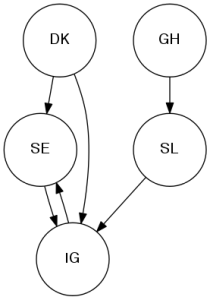
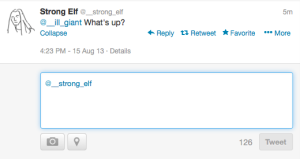
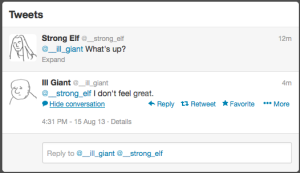
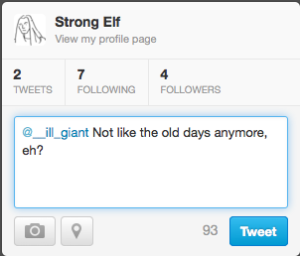
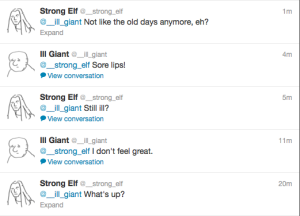
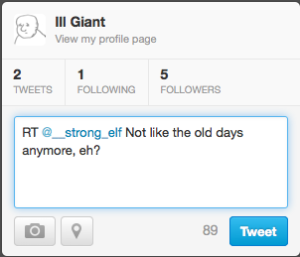

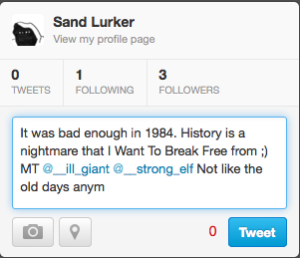

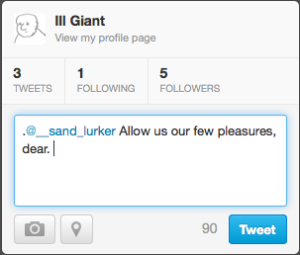
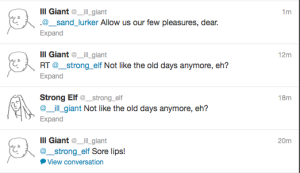
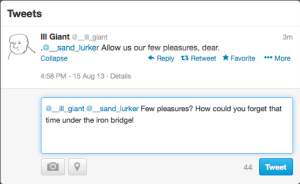
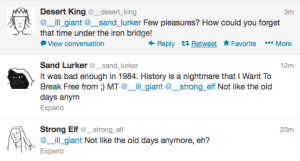


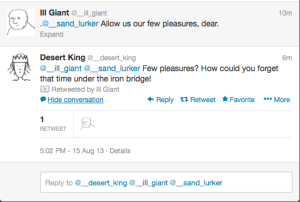
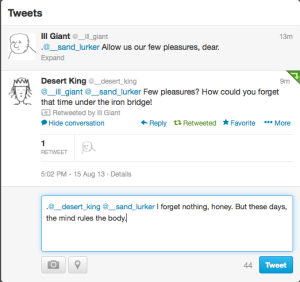
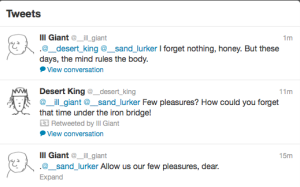
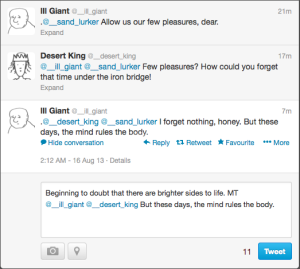
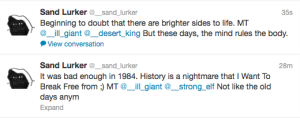
On behalf of all inhabitants of Twin Kingdom Valley, I hereby demand the immediate removal of your inaccurate and libellous blog essay, ‘Twitter conversations, and why it’s just nicer to use the “reply” and “retweet” buttons’. Failure to comply with this demand will result in the strongest possible retaliatory action on our part. However, we are reasonable beings and do not wish to resort to threats. Therefore, I present the following unassailable arguments. They are four in number, although a single one of them should be sufficient to secure the immediate agreement of any rational observer.
First, it is unacceptable to describe people as ‘anoraks’ simply because they enjoy quoting Smiths lyrics. Second, it is clear from many guides to the use of Twitter that a retweet in the classic manner (i.e. using the prefix ‘RT’ or ‘MT’) does the author of the original tweet no less honour than a retweet using Twitter’s ‘Retweet’ button, which is denounced by many authorities as conformist and corrupt. Third, it is defamatory to suggest that the Sand Lurker does not like me. Fourth, I remember you quite well from the 1980s and I am certain that you never completed the game, whether in its original Bug-Byte version or in the mobile version released by Silicon Magic.